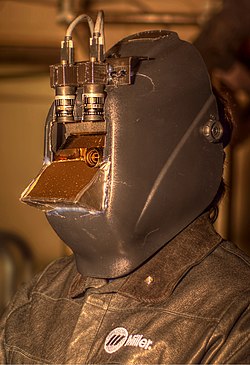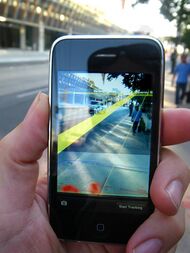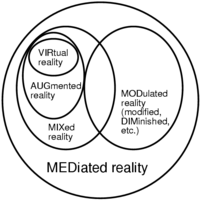Computer-mediated reality

Computer-mediated reality refers to the ability to add to, subtract information from, or otherwise manipulate one's perception of reality through the use of a wearable computer or hand-held device[1] such as a smartphone.
Mediated reality is a proper superset of mixed reality, augmented reality, and virtual reality, as it also includes, for example, diminished reality.[2]
Typically, it is the user's visual perception of the environment that is mediated. This is done through the use of some kind of electronic device, such as an EyeTap device or smart phone, which can act as a visual filter between the real world and what the user perceives. Computer-mediated reality has been used to enhance visual perception as an aid to the visually impaired.[3] This example achieves a mediated reality by altering a video input stream light that would have normally reached the user's eyes, and computationally altering it to filter it into a more useful form. It has also been used for interactive computer interfaces.[4]
The use of computer-mediated reality to diminish perception, by the removal or masking of visual data, has been used for architectural applications, and is an area of ongoing research.[5]
The long-term effects of altering perceived reality have not been thoroughly studied, and negative side effects of long-term exposure might be possible.[citation needed] Short term effects have been demonstrated with the eyestrain caused by computers.[6]
As a seeing aid
In the 1970s and 1980s, Steve Mann introduced the Generation-1 and Generation-2 "Digital Eye Glass", initially as a vision aid to help people see better, as a welding helmet,[7][8][9][10] and as a general-purpose seeing aid for everyday life as outlined in IEEE Technology & Society 31(3)[11] and the supplemental material entitled "GlassEyes".[12]
In this sense, mediated reality is a proper superset of mixed reality, augmented reality, and virtual reality, as it also includes, for example, diminished reality.[13]
Window managers
One common window manager in mediated reality is the "Reality Window Manager".[14]
Wireless mediated reality
With wireless communications, mediated reality can also become a communications medium among different communities.[15] For example, Bluetooth devices are often used with mediated reality.[16] With the use of EyeTap, such interaction is called "seeing eye-to-eye".[17]
Applications
Applications of mediated reality include devices that help people see better, as well as devices for gaming and equipment repair, telemedicine, remote expert advice interfaces, and wayfinding. Mediated reality is also used in robotics[18] and drawing applications such as the "Loose and Sketchy" drawing package.[19]
One key application of computer-mediated reality is healthcare and medicine, which has become a popular research area, specifically beginning in the 1990s with the field growing larger over time.[20] Common research topics include applications of computer-mediated reality in surgery, diagnosing diseases generally, and aiding care of neurodegenerative diseases like Parkinson's.[20] In surgery, studies have shown that the use of virtual reality simulations can be used to reduce error, improve efficiency, and be used generally as training.[20] Other applications in surgery include modeling, which allows for more extensive planning of surgeries prior to the procedure that can also be more personalized to the patient, and image-guided surgery, in which machines and overlays would allow for more accuracy in the surgical processes.[20] There have even been complete telesurgeries, where the surgeon operates on a 3D model of the patient while a robot executes the actions.[20] This has been used for basic surgeries on swine and more advanced surgeries on swine and humans.[20] With neurodegenerative diseases, virtual reality has been used to simulate situations that train memory but aren't reproduce in a standard treatment environment.[20] Virtual reality may also be used for interfacing with a patient in their home, with data sent directly to the physician, or creating games that would encourage these exercises.[20] Virtual reality has also been used to aid those with a fear of heights, anxiety, depression, and autism.[20] It has also been used to reduce patients' pain.[20]
A widely implemented development of computer-mediated reality in medicine is the invention of electronic consultation, such as services like Teladoc.[21]
Within video games, the most common form of computer-mediated reality is virtual reality headsets, such as Oculus Rift.[22] These are devices that attach to the user's head and immerse their field of vision solely within the game world.[22] Controllers used for virtual reality games range from traditionally designed controllers to controllers designed to track the motions of the user.[22] However, alongside the uses previously mention in medical fields,[20] virtual reality has gained notoriety with Meta, formerly known as Facebook,[23] and the introduction of their "metaverse."[24] The metaverse is intended to be designed in a similar fashion to massive multiplayer online games, where users can interact with each other in an interconnected virtual space.[23] It has already been subject to controversy, as a woman claimed she was assaulted in the Metaverse.[25] In addition to virtual reality, augmented reality has also been used for video games. The most prominent example is Pokémon Go, an augmented reality game for mobile devices where Pokémon creatures are displayed through the phone to appear as if they are part of the real world.[26] Other examples of AR games include Harry Potter and Ingress, which was developed by the same developer behind Pokémon Go.
Augmented reality technology has similarly been applied with social media applications such as Snapchat. These lenses range from adding 3D digital objects to pictures to altering the appearance of those in the photos.[27][28][29] One of the most common types are beauty filters, which digitally alter the user's appearance to make the user appear more "beautiful."[30] Beauty filters have been correlated to lower self esteem.[31]
Related concepts
Mediated reality is related to other concepts such as augmented reality (which is a special case of mediated reality), virtual reality, mixed reality, etc.[32]
See also
- Extended reality
- Sensorial transposition
- Philosophy:Simulated reality – Hypothesis that reality could be simulated
- Synthetic vision system
- Ubiquitous computing – Concept in software engineering and computer science
References
- ↑ "Wearable, Tetherless, Computer-Mediated Reality", Technical Report #260, M.I.T. Medial Lab Perceptual Computing Section, Cambridge, Massachusetts, 1994
- ↑ Mann, S., & Fung, J. (2001). Videoorbits on EyeTap devices for deliberately diminished reality or altering the visual perception of rigid planar patches of a real world scene. Proceedings of the Second IEEE International Symposium on Mixed Reality, pp 48-55, March 14–15, 2001.
- ↑ Video mediation
- ↑ Grasset, R.; Gascuel, J. -D.; Schmalstieg (2003). "The Second IEEE and ACM International Symposium on Mixed and Augmented Reality, 2003. Proceedings". ISMAR 2003. pp. 302–303. doi:10.1109/ISMAR.2003.1240731. ISBN 978-0-7695-2006-3.
- ↑ See, for instance, here and here
- ↑ "How to Avoid Eye Strain Caused by Increased Screen Time Amid the COVID-19 Pandemic" (in en). https://healthcare.utah.edu/healthfeed/postings/2020/08/eye-strain-screen-time.php.
- ↑ Quantigraphic camera promises HDR eyesight from Father of AR, by Chris Davies, SlashGear, Sep 12th 2012
- ↑ IEEE Spectrum
- ↑ IEEE Computer
- ↑ A magical welding helmet that lets you see the world in HDR–in real-time
- ↑ Through the Glass, Lightly, IEEE Technology & Society, Volume 31, Number 3, Fall 2012, pages 10-14
- ↑ "GlassEyes": The Theory of EyeTap Digital Eye Glass, supplemental material for "Through the Glass, Lightly", IEEE Technology and Society, Vol. 31, No. 3, Fall 2012
- ↑ Mann, S., & Fung, J. (2001). Videoorbits on EyeTap devices for deliberately diminished reality or altering the visual perception of rigid planar patches of a real world scene. Proceedings of the Second IEEE International Symposium on Mixed Reality, pp 48-55, March 14–15, 2001.
- ↑ Mediated Reality, by Steve Mann, Linux Journal, Article No5, Issue59, 1999march01, ISSN 1075-3583
- ↑ Guo, Z.; Zhu, J. J. H.; Chen, H. (2001). "Mediated Reality Bites: Comparing Direct and Indirect Experience as Sources of Perceptions Across Two Communities in China". Int. J. Public Opin. Res. 13 (4): 398–418. doi:10.1093/ijpor/13.4.398.
- ↑ Mediated Reality Bluetooth Device Locator by S Parikh et al., IEEE CSIDC 2002
- ↑ Tang, F.; Aimone, C.; Fung, J.; Marjan, A.; Mann, S. (2002). "Proceedings. International Symposium on Mixed and Augmented Reality". ISMAR’02. pp. 267–268. doi:10.1109/ISMAR.2002.1115106. ISBN 978-0-7695-1781-0.
- ↑ Daniel Suarez: Daemon: Bot-mediated Reality (discussion of Mediated and Augmented Reality, bots, etc.)
- ↑ Haller, M.; Landerl, F.; Billinghurst, M. (2005). "Proceedings of the 3rd international conference on Computer graphics and interactive techniques in Australasia and South East Asia". GRAPHITE '05. pp. 371–379. doi:10.1145/1101389.1101463. ISBN 978-1-59593-201-3.
- ↑ 20.00 20.01 20.02 20.03 20.04 20.05 20.06 20.07 20.08 20.09 20.10 Yeung, A., Tosevska, A., Klager, E., Eibensteiner, F., Laxar, D., Stoyanov, J., Glisic, M., Zeiner, S., Kulnik, S. T., Crutzen, R., Kimberger, O., Kletecka-Pulker, M., Atanasov, A. G., & Willschke, H (10 February 2021). "Virtual and Augmented Reality Applications in Medicine: Analysis of the Scientific Literature". Journal of Medical Internet Research 23 (2): e25499. doi:10.2196/25499. PMID 33565986.
- ↑ "Telemedicine Technology _ Medicwell Telemedicine Platform" (in en-US). 2021-06-10. https://medicwell.com/blog/telemedicine-technology/.
- ↑ 22.0 22.1 22.2 "The complete guide to virtual reality – everything you need to get started" (in en). 2016-11-10. http://www.theguardian.com/technology/2016/nov/10/virtual-reality-guide-headsets-apps-games-vr.
- ↑ 23.0 23.1 "Facebook announces name change to Meta in rebranding effort" (in en). 2021-10-28. https://www.theguardian.com/technology/2021/oct/28/facebook-name-change-rebrand-meta.
- ↑ Ravenscraft, Eric. "What Is the Metaverse, Exactly?" (in en-US). Wired. ISSN 1059-1028. https://www.wired.com/story/what-is-the-metaverse/. Retrieved 2022-06-01.
- ↑ Sparks, Hannah (2021-12-17). "Woman claims she was virtually 'groped' in Meta's VR metaverse" (in en-US). https://nypost.com/2021/12/17/woman-claims-she-was-virtually-groped-in-meta-vr-metaverse/.
- ↑ "How "Pokemon Go" Took Augmented Reality Mainstream" (in en-US). https://knowledge.wharton.upenn.edu/article/how-pokemon-go-took-augmented-reality-mainstream/.
- ↑ Newton, Casey (2017-04-18). "Snapchat adds world lenses to further its push into augmented reality" (in en). https://www.theverge.com/2017/4/18/15333130/snapchat-world-lenses-something-new-for-facebook-to-copy.
- ↑ "Snapchat introduces World Lenses – live filters for just about anything" (in en-US). https://social.techcrunch.com/2017/04/18/snapchat-introduces-world-lenses-live-filters-for-just-about-anything/.
- ↑ Lavanya (2021-08-30). "An Ultimate Guide on Snapchat Lenses | How to Enable & Use Lenses On Snapchat? List of Best Snapchat Lenses Codes" (in en-US). https://versionweekly.com/news/snapchat/snapchat-lenses-ultimate-guide/.
- ↑ Shein, Esther (November 2021). "Filtering for beauty" (in en). Communications of the ACM 64 (11): 17–19. doi:10.1145/3484997. ISSN 0001-0782. https://dl.acm.org/doi/10.1145/3484997.
- ↑ "Is that really me? The ugly truth about beauty filters" (in en). 2022-01-01. https://www.theguardian.com/lifeandstyle/2022/jan/02/is-that-really-me-the-ugly-truth-about-beauty-filters.
- ↑ Mediated Reality with implementations for everyday life , Presence Connect, MIT Press journal PRESENCE: Teleoperators and Virtual Environments, Date Posted: 2002 August 6
External links
- EyeTap.org Mediated Reality Research
- Mediated Reality based on the VideoOrbits head tracker
- Diminished Reality example to show something where Mediated Reality is definitely a proper superset of Augmented Reality
 |




